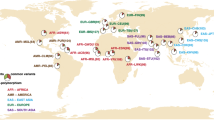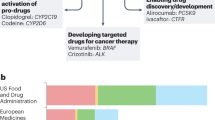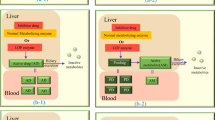Key Points
-
Polymorphic drug-metabolizing enzymes (DME) are likely to represent some of the most common inheritable risk factors associated with common 'disease' phenotypes, such as adverse drug reactions.
-
The relatively high degree of association between DME polymorphisms and clinical phenotypes, examples of which are discussed here, suggests that research into this class of polymorphisms will provide near-term benefits to patients.
-
Given the complexity of the body's reactions to pharmacological agents and the combinatoric magnitude of the resulting analysis problem, traditional analysis methods will often break down. Novel analysis techniques, such as multifactor dimensionality reduction (MDR), offer viable options for evaluating complex pharmacogenetic data.
-
The MDR method, which has been successfully applied to identifying gene–gene and gene–environment interactions for a variety of complex clinical endpoints, can be implemented as part of a comprehensive and flexible four-step framework for combinatorial data mining. The open-source and platform-independent version of the MDR software is freely available for download.
-
We propose the application of MDR to defining gene–gene interactions in a similar context directed toward the characterization of drug-treatment outcomes. The application of this method, and others like it, could lead to the development of improved gene-based dosing models, and facilitate safer drug prescribing through the prospective application of individual drug susceptibility profiles.
Abstract
Combinatorial pharmacogenetics seeks to characterize genetic variations that affect reactions to potentially toxic agents within the complex metabolic networks of the human body. Polymorphic drug-metabolizing enzymes are likely to represent some of the most common inheritable risk factors associated with common 'disease' phenotypes, such as adverse drug reactions. The relatively high concordance between polymorphisms in drug-metabolizing enzymes and clinical phenotypes indicates that research into this class of polymorphisms could benefit patients in the near future. Characterization of other genes affecting drug disposition (absorption, distribution, metabolism and elimination) will further enhance this process. As with most questions concerning biological systems, the complexity arises out of the combinatorial magnitude of all the possible interactions and pathways. The high-dimensionality of the resulting analysis problem will often overwhelm traditional analysis methods. Novel analysis techniques, such as multifactor dimensionality reduction, offer viable options for evaluating such data.
This is a preview of subscription content, access via your institution
Access options
Subscribe to this journal
Receive 12 print issues and online access
$209.00 per year
only $17.42 per issue
Buy this article
- Purchase on Springer Link
- Instant access to full article PDF
Prices may be subject to local taxes which are calculated during checkout


Similar content being viewed by others
References
Lander, E. S. et al. Initial sequencing and analysis of the human genome. Nature 409, 860–921 (2001).
Venter, J. C. et al. The sequence of the human genome. Science 291, 1304–1351 (2001).
Wilke, R. A., Musana, A. K. & Weber, W. W. Cytochrome P450 gene-based drug prescribing and factors impacting translation into routine clinical practice. Personalized Med. 2, 213–224 (2005).
Ingelman-Sundberg, M. Pharmacogenetics: an opportunity for a safer and more efficient pharmacotherapy. J. Intern. Med. 250, 186–200 (2001).
Burke, W. Genomic medicine — genetic testing. N. Engl. J. Med. 347, 1867–1875 (2002).
Moirand, R. et al. HFE based re-evaluation of heterozygous hemochromatosis. Am. J. Med. Genet. 111, 356–361 (2002).
Higashi, M. K. et al. Association between CYP2C9 genetic variants and anticoagulation-related outcomes during warfarin therapy. JAMA 287, 1690–1698 (2002). Seminal paper in the field of warfarin pharmaco-genetics, linking clinical outcome with variation in a single drug metabolizing enzyme gene (in the context of a drug with a narrow therapeutic index).
Hillman, M. A. et al. Relative impact of covariates in prescribing warfarin according to CYP2C9-based genotype. Pharmacogenetics 14, 539–547 (2004).
Gage, B. F. et al. Use of pharmacogenetics and clinical factors to predict the maintenance dose of warfarin. Thromb. Haemost. 91, 87–94 (2004).
Scordo, M. G. et al. Influence of CYP2C9 and CYP2C19 genetic polymorphisms on warfarin maintenance dose and metabolic clearance. Clin. Pharmacol. Ther. 72, 702–710 (2002).
Wadelius, M. et al. Warfarin sensitivity related to CYP2C9, CYP3A5, ABCB1 (MDR1) and other factors. Pharmacogenomics J. 4, 40–48 (2004).
Kirchheiner, J. et al. Pharmacogenetics of antidepressants and antipsychotics: the contribution of allelic variations to the phenotype of drug response. Mol. Psychiatry 9, 442–473 (2004).
Weber, W. W. The legacy of pharmacogenetics and potential applications. Mutat. Res. 479, 1–18 (2001). A historical review with a discussion of outlook at the turn of the millennium.
Anderson, G. D. Pharmacogenetics and enzyme induction/inhibition properties of antiepileptic drugs. Neurology 63, S3–S8 (2004).
Komatsu, T. et al. Formation of a dihydroxy metabolite of phenytoin in human liver microsomes/cytosol: roles of cytochromes P450 2C9, 2C19, and 3A4. Drug. Metab. Dispos. 28, 1361–1368 (2000).
Chua, H. C., Venketasubramanian, N., Tjia, H. & Chan, S. P. Elimination of phenytoin in toxic overdose. Clin. Neurol. Neurosurg. 102, 6–8 (2000).
Kerb, R. et al. The predictive value of MDR1, CYP2C9, and CYP2C19 polymorphisms for phenytoin plasma levels. Pharmacogenomics J. 1, 204–210 (2001).
Hung, C. C., Lin, C. J., Chen, C. C., Chang, C. J. & Liou, H. H. Dosage recommendation of phenytoin for patients with epilepsy with different CYP2C9/CYP2C19 polymorphisms. Ther. Drug Monit. 26, 534–540 (2004).
De Morais, S. M. et al. Identification of a new genetic defect responsible for the polymorphism of (S)-mephenytoin metabolism in Japanese. Mol. Pharmacol. 46, 594–598 (1994).
De Morais, S. M. et al. The major genetic defect responsible for the polymorphism of S-mephenytoin metabolism in humans. J. Biol. Chem. 269, 15419–15422 (1994).
Wrighton, S. A. et al.: Isolation and characterization of human liver cytochrome P450 2C19: correlation between 2C19 and S-mephenytoin 4′-hydroxylation. Arch. Biochem. Biophys. 306, 240–245 (1993).
Pitner, J. K., Long, L. D., Meyer, R. P. & Pennypacker, L. C. Phenytoin toxicity in an older patient with slow metabolism and atypical presentation. Pharmacotherapy 18, 218–225 (1998).
Lee, A. Y., Kim, M. J., Chey, W. Y., Choi, J. & Kim, B. G. Genetic polymorphism of cytochrome P450 2C9 in diphenylhydantoin-induced cutaneous adverse drug reactions. Eur. J. Clin. Pharmacol. 60, 155–159 (2004).
Levy, G. N., Weber, W. W. in Interindividual Variability in Human Drug Metabolism (eds Pacifia, C. M. & Pelkonen, O.) 333–357 (Taylor and Francis, New York, 2001).
Levy, G. N. & Weber, W. W. in Enzyme Systems that Metabolize Drugs and Other Xenobiotics (ed. Ionnides, C.) 441–457 (Wiley, New York, 2002).
Neville, M. et al. Characterization of cytochrome P450 2D6 alleles using the invader system. BioTechniques 32, 34–43 (2002).
Iyer, L. et al. Genetic predisposition to the metabolism of irinotecan (CPT-11). Role of uridine diphosphate glucuronosyltransferase isoform 1A1 in the glucuronidation of its active metabolite (SN-38) in human liver microsomes. J. Clin. Invest. 101, 847–854 (1998).
Iyer, L. et al. UGT1A1*28 polymorphism as a determinant of irinotecan disposition and toxicity. Pharmacogenomics J. 2, 43–47 (2002).
Ando, Y. et al. Polymorphisms of UDP-glucuronosyltransferase gene and irinotecan toxicity: a pharmacogenetic analysis. Cancer Res. 60, 6921–6926 (2000).
Atorvastatin Product Monograph (Parke-Davis Division of Warner Lamber, Morris Plains, 1997).
Bullen, W. W., Miller, R. A. & Hayes, R. N. Development and validation of a high-performance liquid chromatography tandem mass spectrometry assay for atorvastatin, ortho-hydroxy atorvastatin, and para-hydroxy atorvastatin in human, dog, and rat plasma. J. Am. Soc. Mass. Spectrom. 10, 55–66 (1999).
Jemal, M., Ouyang, Z., Chen, B. C. & Teitz, D. Quantitation of the acid and lactone forms of atorvastatin and its biotransformation products in human serum by high-performance liquid chromatography with electrospray tandem mass spectrometry. Rapid Commun. Mass. Spectrom. 13, 1003–1015 (1999).
Prueksaritanont, T. et al. Effects of fibrates on metabolism of statins in human hepatocytes. Drug Metab. Dispos. 30, 1280–1287 (2002).
Prueksaritanont, T. et al. Mechanistic studies on metabolic interactions between gemfibrozil and statins. J. Pharmacol. Exp. Ther. 301, 1042–1051 (2002).
Nishizato, Y. et al. Polymorphisms of OATP-C (SLC21A6) and OAT3 (SLC22A8) genes: consequences for pravastatin pharmacokinetics. Clin. Pharmacol. Ther. 73, 554–565 (2003).
Mwinyi, J., Johne, A., Bauer, S., Roots, I. & Gerloff, T. Evidence for inverse effects of OATP-C (SLC21A6) 5 and 1b haplotypes on pravastatin kinetics. Clin. Pharmacol. Ther. 75, 415–421 (2004).
Schneck, D. W. et al. The effect of gemfibrozil on the pharmacokinetics of rosuvastatin. Clin. Pharmacol. Ther. 75, 455–463 (2004).
Davidson, M. H. Controversy surrounding the safety of cerivastatin. Expert Opin. Drug Saf. 1, 207–212 (2002).
Shitara, Y., Hirano, M., Sato, H. & Sugiyama, Y. Gemfibrozil and its glucuronide inhibit the OATP2(OATP1B1: SLC21A6)-mediated hepatic uptake and CYP2C8-mediated metabolism of cerivastatin- Analysis of the mechanism of the clinically relevant drug-drug interaction between cerivastatin and gemfibrozil. J. Pharmacol. Exp. Ther. 311, 228–236 (2004).
Wilke, R. A., Moore, J. H. & Burmester, J. K. Relative impact of CYP 3A genotype and concomitant medication on the severity of atorvastatin-induced muscle damage. Pharmacogenet. Genomics 15, 415–421 (2005). Recent paper in the field of statin pharmacogenetics, linking adverse outcome with variation in a single drug metabolizing enzyme gene (in the context of a drug with a wide therapeutic index).
Shikata, E. et al. Association of pharmacokinetic (CYP2C9) and pharmacodynamic (factors II, VII, IX, and X; proteins S and C; and gamma-glutamyl carboxylase) gene variants with warfarin sensitivity. Blood 103, 2630–2635 (2004).
Li, T. et al. Identification of the gene for vitamin K epoxide reductase. Nature 427, 541–544 (2004).
Rost, S. et al. Mutations in VKORC1 cause warfarin resistance and multiple coagulation factor deficiency type 2. Nature 427, 537–541 (2004).
Kirchheiner, J. et al. Pharmacogenetics of antidepressants and antipsychotics: the contribution of allelic variations to the phenotype of drug response. Mol. Psych. 9, 442–473 (2004).
Moore, J. H. The ubiquitous nature of epistasis in determining susceptibility to common human diseases. Hum. Hered. 56, 73–82 (2003). Argues that epistasis or gene–gene interactions play an important role in susceptibility to common human diseases.
Moore, J. H. & Ritchie, M. D. The challenges of whole-genome approaches to common diseases. JAMA 291, 1642–1643 (2004). Reviews the challenges associated with identifying susceptibility genes for common human diseases using genome-wide maps of single-nucleotide polymorphisms (SNPs).
Moore, J. H. & Williams, S. M. Traversing the conceptual divide between biological and statistical epistasis: systems biology and a more modern synthesis. BioEssays 27, 637–646 (2005). Highlights the challenges associated with inferring etiology from statistical models in genetic studies of human disease.
Moore, J. H. A global view of epistasis. Nature Genet. 37, 13–14 (2005).
Hosmer, D. W. & Lemeshow, S. Applied Logistic Regression (John Wiley & Sons, Inc., New York, 2000).
Bellman, R . Adaptive Control Processes (Princeton Univ. Press, Princeton, 1961).
Concato, J., Feinstein, A. R. & Holford, T. R. The risk of determining risk with multivariable models. Ann. Intern. Med. 118, 201–210 (1993).
Peduzzi, P., Concato, J., Kemper, E., Holford, T. R. & Feinstein, A. R. A simulation study of the number of events per variable in logistic regression analysis. J. Clin. Epidemiol. 49, 1373–1379 (1996).
Wade, M. J. in Epistasis and the Evolutionary Process (eds Wolf, J., Brodie III, B. & Wade, M. J.) 213–231 (Oxford Univ. Press, New York, 2000).
Templeton, A. R. in Epistasis and the Evolutionary Process (eds Wolf, J., Brodie III, B. & Wade, M. J.) 41–57 (Oxford Univ. Press, New York, 2000).
Thornton-Wells, T. A., Moore, J. H. & Haines, J. L. Genetics, statistics and human disease: analytical retooling for complexity. Trends Genet. 20, 640–647 (2004). Recent review of the factors that can complicate a genetic analysis. Highlights the need for powerful analytical strategies such as multifactor dimensionality reduction (MDR).
Ritchie, M. D. et al. Multifactor-dimensionality reduction reveals high-order interactions among estrogen-metabolism genes in sporadic breast cancer. Am. J. Hum. Genet. 69, 138–147 (2001).
Hahn, L. W., Ritchie, M. D. & Moore, J. H. Multifactor dimensionality reduction software for detecting gene-gene and gene-environment interactions. Bioinformatics 19, 376–382 (2003).
Ritchie, M. D., Hahn, L. W. & Moore, J. H. Power of multifactor dimensionality reduction for detecting gene-gene interactions in the presence of genotyping error, missing data, phenocopy, and genetic heterogeneity. Genet. Epidemiol. 24, 150–157 (2003).
Hahn, L. W. & Moore, J. H. Ideal discrimination of discrete clinical endpoints using multilocus genotypes. In Silico Biol. 4, 183–194 (2004).
Moore, J. H. Computational analysis of gene-gene interactions using multifactor dimensionality reduction. Expert Rev. Mol. Diagn. 4, 795–803 (2004). A recent review of the multifactor dimensionality reduction (MDR) approach to detecting gene–gene and gene–environment interactions.
Hastie, T., Tibshirani, R. & Friedman, J. The Elements of Statistical Learning: Data Mining, Inference, and Prediction (Springer-Verlag, New York, 2001).
Good, P. Permutation Tests: A Practical Guide to Resampling Methods for Testing Hypotheses (Springer, New York, 2000).
Coffey, C. S. et al. An application of conditional logistic regression and multifactor dimensionality reduction for detecting gene-gene interactions on risk of myocardial infarction: the importance of model validation. BMC Bioinformatics 5, 49 (2004).
Coffey, C. S. et al. Reporting of model validation procedures in human studies of genetic interactions. Nutrition 20, 69–73 (2004).
Tsai, C. T. et al. Renin-angiotensin system gene polymorphisms and atrial fibrillation. Circulation 109, 1640–1646 (2004).
Cho, Y. M. et al. Multifactor dimensionality reduction reveals interactions among the UCP2 and PPARg genes in type 2 diabetes. Diabetologia 47, 549–554 (2004).
Soares, M. L. et al. Susceptibility and modifier genes in Portuguese transthyretin V30M amyloid polyneuropathy: complexity in a single-gene disease. Hum. Mol. Genet. 14, 543–553 (2005).
Bastone, L., Reilly, M., Rader, D. J. & Foulkes, A. S. MDR and PRP: a comparison of methods for high-order genotype–phenotype associations. Hum. Hered. 58, 82–92 (2004).
Moore, J. H. & Williams, S. M. New strategies for identifying gene–gene interactions in hypertension. Ann. Med. 34, 88–95 (2002).
Williams, S. M. et al. Multilocus analysis of hypertension: a hierarchical approach. Hum. Hered. 57, 28–38 (2004).
Qin, S. et al. An association study of the N-methyl-D-aspartate receptor NR1 subunit gene (GRIN1) and NR2B subunit gene (GRIN2B) in schizophrenia with universal DNA microarray. Eur. J. Hum. Genet. (in the press).
National Institute of Health Care Management Research and Education Foundation. Prescription drug expenditures in 2001: another year of escalating costs (NIHCM, Washington DC, 2002).
Lord, P. G. & Papoian, T. Genomics and drug toxicity. Science 306, 575 (2004).
Davis, R. L. & Khoury, M. J. The promise of personalized medicine. Personalized Med. 2, 1–4 (2005).
McCarty, C. et al. The Marshfield Clinic Personalized Medicine Research Project (PMRP) — design, methods and initial recruitment results for a population-based DNA biobank. Personalized Med. 2, 49–79 (2005). Design and construction of a large population-based DNA Biobank ( n = 18,500 participants), located in Central Wisconsin. Discusses integration with similar ongoing efforts, worldwide. In addition to describing the basic demographics of the first 17,000 participants enrolled, the authors provide copies of study materials, including the questionnaire and the informed consent document. This open sharing of resource tools should help facilitate collaboration between research groups, addressing one of the 'Grand Challenges' identified by Francis Khoury, the Head of the National Human Genome Research Institute, upon completion of the Human Genome Project.
Wilke, R. A., Carillo, M. W. & Ritchie, M. D. Pacific Symposium on Biocomputing — computational approaches for pharmacogenomics. Pharmacogenomics 6, 111–113 (2005).
Hoh, J., Wille, A. & Ott, J. Trimming, weighting, and grouping SNPs in human case-control association studies. Genome Res. 11, 2115–2119 (2001).
Culverhouse, R., Klein, T. & Shannon, W. Detecting epistatic interactions contributing to quantitative traits. Genet. Epidemiol. 27, 141–152 (2004).
Moore, J. H. et al. A flexible computational framework for detecting, characterizing, and interpreting statistical patterns of epistasis in genetic studies of human disease susceptibility. J. Theor. Biol. (in the press).
Jakulin, A. & Bratko, I. Analyzing attribute interactions. Lecture Notes Artificial Intelligence 2838, 229–240 (2003).
Jakulin, A., Bratko, I., Smrke, D., Demsar, J. & Zupan, B. Attribute interactions in medical data analysis. Lecture Notes Artificial Intelligence 2780, 229–238 (2003).
Frank, E., Hall, M., Trigg, L., Holmes, G. & Witten, I. H. Data mining in bioinformatics using Weka. Bioinformatics 20, 2479–2481 (2004).
Acknowledgements
This work was supported by grants from the National Institutes of Health (NIH). D.M.R. was supported by an NIH training grant.
Author information
Authors and Affiliations
Corresponding author
Ethics declarations
Competing interests
The authors declare no competing financial interests.
Related links
Related links
DATABASES
Entrez Gene
FURTHER INFORMATION
Home Page of the Human Cytochrome P450 (CYP) Allele Nomenclature Committee
Rights and permissions
About this article
Cite this article
Wilke, R., Reif, D. & Moore, J. Combinatorial Pharmacogenetics. Nat Rev Drug Discov 4, 911–918 (2005). https://doi.org/10.1038/nrd1874
Issue Date:
DOI: https://doi.org/10.1038/nrd1874
This article is cited by
-
Association between SLCO1B1 −521T>C and −388A>G polymorphisms and risk of statin-induced adverse drug reactions: A meta-analysis
SpringerPlus (2016)
-
The Clinical Pharmacogenomics Implementation Consortium: CPIC Guideline for SLCO1B1 and Simvastatin-Induced Myopathy
Clinical Pharmacology & Therapeutics (2012)
-
The Emerging Role of Electronic Medical Records in Pharmacogenomics
Clinical Pharmacology & Therapeutics (2011)
-
High-density lipoprotein (HDL) cholesterol: leveraging practice-based biobank cohorts to characterize clinical and genetic predictors of treatment outcome
The Pharmacogenomics Journal (2011)
-
Dexamethasone-Induced FKBP51 Expression in Peripheral Blood Mononuclear Cells Could Play a Role in Predicting the Response of Asthmatics to Treatment with Corticosteroids
Journal of Clinical Immunology (2011)



